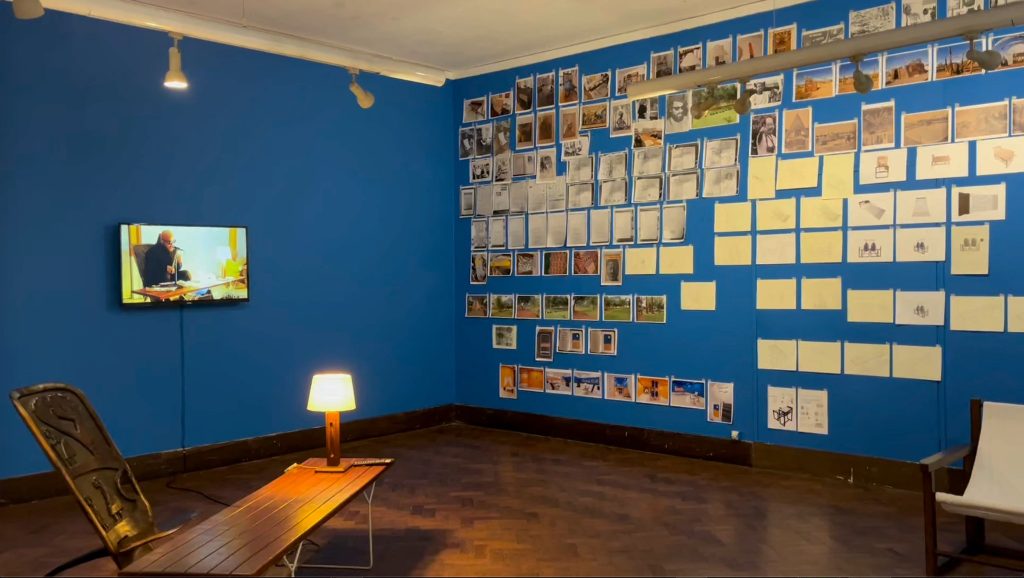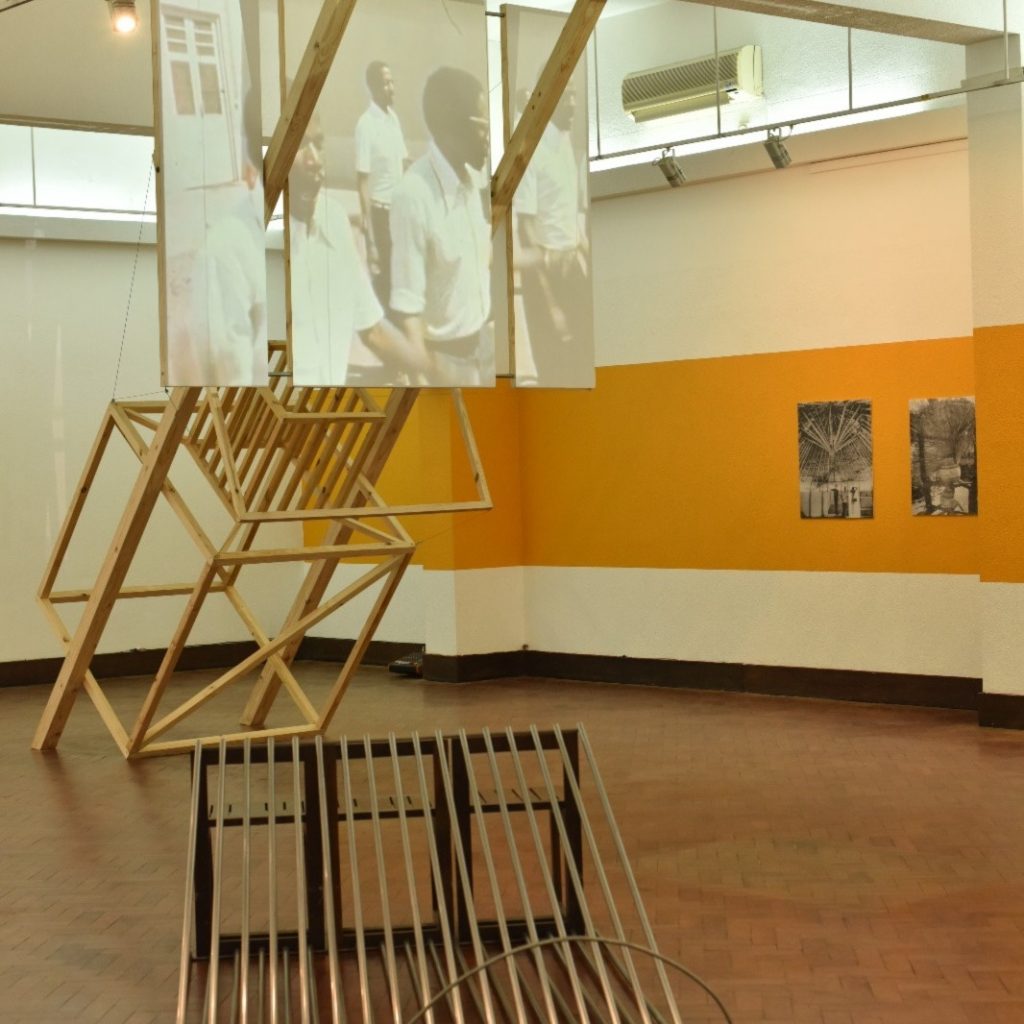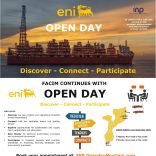Mozambique: ENI Open Day
Ângela Ferreira in collaboration with Alda Costa: Experimental Field @ MUSART, Maputo

Ângela Ferreira in collaboration with Alda Costa: Experimental Field @ MUSART, Maputo
Experimental Field: Ângela Ferreira, in Collaboration with Alda Costa, explores material and environmental research undertaken in the early years of Mozambique’s independence. The exhibition takes its name from an outdoor agricultural learning laboratory maintained at Eduardo Mondlane University’s campus, where university staff, researchers and students worked together to produce food, design resources, tools and structures, and train farmers and community technicians. This experimental site was coordinated by TBARN (Técnicas Básicas de Aproveitamento de Recursos Naturais), a research group formed in the early years of the socialist government to improve farmers’ production and quality of life with minimal resources.
Ângela Ferreira builds on TBARN’s visual and textual remains to reveal the revolutionary ethos that made Mozambique a global centre for radical experimentation in the 1970s and early 1980s.
The exhibition expands on Ferreira’s research-based practice and its search for the contemporaneity of the past. Experimental Field emerges from the artist’s ongoing dialogue with Alda Costa, a pioneer Mozambican art historian and cultural worker whose lived experience during socialism and scholarship thereafter have made her living memory of an unmatched moment in cultural history. In the exhibition, historical objects from Costa’s milieu and personal collection are displayed alongside Ferreira’s work. These objects’ design reveals the period’s placement of material conditions at the forefront of cultural production. Through this dialogue, Ferreira’s works investigate histories that simultaneously express political pragmatism and creative playfulness, being locally grounded and international in their reach.
Originally opened at the @rialto6_art contemporary art space in Lisbon, Angela Ferreira’s first solo exhibition in a public institution in Mozambique, the National Museum of Arts, arrived in Maputo in an expanded format.
The exhibition explores material and environmental research carried out in the first years of the country’s independence (1975) involving different work fronts. The title of the exhibition specifically refers to the name of an agricultural learning space maintained on the Eduardo Mondlane University campus from 1976, where staff, researchers and students worked together to produce food, design tools and structures, and train farmers, peasants and community technicians.
Thiss experimental site was coordinated by the TBARN Study Centre (Técnicas Básicas de Aproveitamento de Recursos Naturais/Basic Techniques for Harnessing Natural Resources), a broad research group formed in the early years of the post-independence revolution to, among other things, improve production and the quality of life of farmers with minimal resources.
Ferreira draws on TBARN’s visual and textual traces to reveal the revolutionary spirit that made Mozambique a global centre of radical experimentation in the 1970s and early 1980s
The project expands Ferreira’s research practice and her search for the contemporaneity of the past. ‘Campo Experimental’ emerges from the artist’s ongoing dialogue with Alda Costa, a Mozambican art historian and cultural worker whose lived experience during the period of the post-independence socialist revolution and subsequent years, as well as her later studies, make her a living memory of an incomparable moment in cultural history.
In the exhibition, historical objects from Costa’s personal collection are displayed alongside Ferreira’s work. The design of these objects highlights the importance of material conditions at the forefront of cultural production in the early years of independent Mozambique. These characteristics accentuate the TBARN aesthetic present throughout the exhibition: the multifunctional use of simple materials, the emphasis on the angular shapes of objects intended for pragmatic use and the vibrant colours on the walls, based on the information pamphlets produced by the university (Queimadas, 1977). Ferreira emphasizes the experimental nature of TBARN by transforming some structures developed at the time into strictly aesthetic objects – aesthetic thinking becomes a productive method for reimagining aspects of rural life under a new model of collectively.
Originally opened at the Rialto6 contemporary art space in Lisbon, the exhibition arrives in Maputo in an expanded format: it includes videos of musician Scúru Fitchádu in a performance commissioned for the exhibition, photographs by Kok Nam of TBARN’s experimental campus, and images used by Ferreira in the process of creating his works. Other works referring to Mozambique were included in the exhibition in this version presented at MUSART, including ‘For Mozambique’ (2008), shown for the first time in the country.
Through a dialogue between diverse voices and temporalities, Ferreira’s works investigate stories that express both political pragmatism and creative playfulness, being both locally rooted and internationally far-reaching.
The exhibition is curated by Álvaro Luís Lima and Paula Nascimento.
- Open until 16 February 2025 at MUSART, Museu Nacional de Arte.
- Address: Avenida Ho Chi Minh 1233, in Maputo city.
- Exhibition opening hours for visitors:
- From Tuesday to Frida: 9 a.m. to 6 p.m.
- Saturdays and Sundays from 9 a.m. to 5 p.m.

Artist’s biography
Ângela Ferreira, born in 1958 in Maputo, Mozambique, grew up in South Africa and obtained her MFA from the Michaelis School of Fine Art, University of Cape Town. She lives and works in Lisbon, where she obtained her doctorate in 2016. She believes in education as a political contribution to society and continues to teach in Portugal (Faculty of Fine Art Lisbon University) and in Mozambique.
Ferreira’s multi-disciplinary practice is concerned with the ongoing impact of colonialism and post-colonialism on contemporary society, an investigation that is conducted through in-depth research and distillation of ideas into concise and resonant forms. The contribution of this artistic practice lies in the construction of a solid and non-pamphleteering artistic decolonial discourse
The source of her archival reference materials often triangulates the three countries of her personal history: South Africa, Mozambique and Portugal in works like Zip Zap Circus School (2000-2024). Her later works focus on a more positive construction of an African identity. Her sculptural, sound and video-graphic works pay homage to unexpected figures like Peter Blum, Carlos Cardoso, Ingrid Jonker, Jimi Hendrix, Jorge dos Santos, Diego Rivera, Miriam Makeba, Jorge Ben Jor, Angela Davis, Forough Farrokzhad, Gustav Klucis or Mozambican historian Alda Costa. These later works have continuously referenced economic, political and cultural history of the African continent whilst recuperating the work and image of unexpected role model figures.
She represented Portugal at the 52nd Venice Biennale in 2007, continuing her investigations into the ways in which European modernism to adapted or failed to adapt to the realities of the African continent by tracing the history of Jean Prouvé’s’ Maison Tropicale’. Architecture also serves as a starting point for the deepening of her long research on the erasure of colonial memory and the refusal of reparation, which finds its most complex materialization in A Tendency to Forget (2015) focusing on ethnographic work of the couple Jorge and Margot Dias. The Pan African Unity Mural (2018), exhibited at the Maat Museum Lisbon and Bildmuseet, Sweden. Was conceived to think about trajectories and intersections in Africa. In addition to her own trajectory, other biographical stories are simultaneously narrated, exposed and hidden in this work. In Dalaba: Sol d’Exil (2019) a work focused on Miriam Makeba, one of the most prominent figures in the struggle against apartheid, Ferreira created sculptural pieces based on the architectural elements of the exile building where Makeba lived in Conakri, almost like a prototype of the relationship between modernist and African vernacular architectures. Rádio Voz da Liberdade (2022) pays tribute to the essential role played by radio stations in the dissemination of independence struggles around the world, such as the Portuguese radio station Rádio Voz da Liberdade, which was hosted by the RTA Radio Diffusion Television Algerienne from 1962 to 1974 until the fall of the dictatorial regime of the New State. A rare moment of an African radio station supporting the liberation of a European country.
Campo Experimental (2024) pays tribute to the visionary work of a research group in Mozambique – TBARN (Técnicas Básicas de Aproveitamento de Recursos Naturais/ Basic Techniques for Harnessing Natural Resources) – as well as crediting the authorial input of Mozambican historian Alda Costa

- Recent works
Talk Tower For Miriam Makeba (2024); Experimental Field (2024); Klucis goes to Algeria (2023); Rádio Voz da Liberdade (2022); Realistic Manifesto (Gabo’s Fundamental Principles of Constructivist Practice) (2022); Heavier than Heaven (2021); #BucketsystemMustFall (2021); A Spontaneous Tour of Some Monuments of African Architecture (2021); Talk Tower for Forough Farrokhzad (2020); 1 Million Roses for Angela Davis (2020); Rugby (2020); Dalaba: Sol d’Exil (2019); Pan African Unity Mural (2018); Talk Tower for Diego Rivera (2017); Wattle and Daub (2016); A Tendency to Forget (2015); Cha Cha Independence (2014); Monte Mabu (2013); Talk Tower for Ingrid Jonker (2012); Stone Free (2012); Collapsing Structures/ Talking Buildings (2012); Cape Sonnets (2010/2012); For Mozambique (2008). Maison Tropicale (2007).
Source: Buala / Camões - Centro Cultural Português em Maputo - Media Release/ Angela Fereira / Riatlo6


Leave a Reply
Be the First to Comment!
You must be logged in to post a comment.
You must be logged in to post a comment.